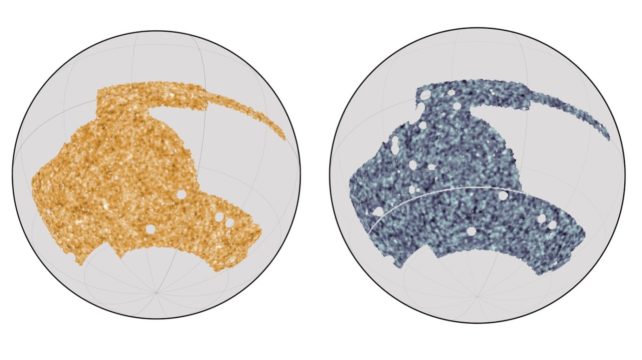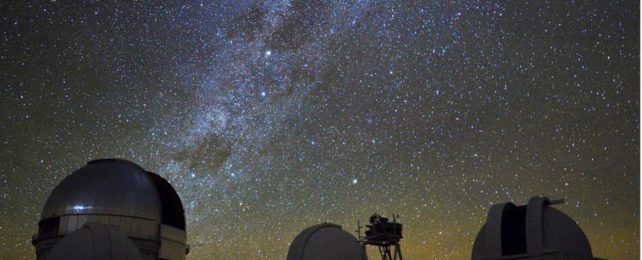A gargantuan effort by a huge international team of scientists has just given us the most precise map of the all matter in the Universe obtained to date.
By combining data from two major surveys, the international collaboration has revealed where the Universe does and doesn't keep all its junk – not just the normal matter that makes up the planets, stars, dust, black holes, galaxies, but the dark matter, too: the mysterious invisible mass generating more gravity than the normal matter can account for.
The resulting map, showing where the matter has congregated over the 13.8-billion-year lifespan of the Universe, will be a valuable reference for scientists looking to understand how the Universe evolved.
Indeed, the results already show that the matter isn't distributed quite how we thought it was, suggesting there could be something missing from the current standard model of cosmology.
According to the current models, at the point of the Big Bang, all the matter in the Universe was condensed into a singularity: a single point of infinite density and extreme heat that suddenly burst and spewed forth quarks that rapidly combined to form a soup of protons, neutrons and nuclei. Hydrogen and helium atoms came a few hundred thousand years later; from these, the entire Universe was made.
How these early atoms spread out, cooled, clumped together, formed stars and rocks and dust, is detective work based on how the Universe around us appears today. And one of the major clues we've used is where all the matter is now – because scientists can then work backwards to figure out how it got there.
But we can't see all of it. In fact, most of the matter in the Universe – around 75 percent – is completely invisible to our current detection methods.
We've only detected it indirectly, because it creates stronger gravitational fields than there should be just based on the amount of normal matter. This manifests in such phenomena as galaxies spinning faster than they should, and a little quirk of the Universe we call gravitational lensing.
When something in the Universe has enough mass – for example, a cluster of thousands of galaxies – the gravitational field around it becomes strong enough to influence the curvature of space-time itself.
That means that any light that travels through that region of space does so along a curved path, resulting in warped and magnified light. These lenses, too, are stronger than they should be if they were only being created by normal matter.
To map the matter in the Universe, researchers compared gravitational lens data collected by two different surveys – the Dark Energy Survey, which collected data in near-ultraviolet, visible, and near-infrared wavelengths; and the South Pole Telescope, which collects data on the cosmic microwave background, the faint traces of radiation left over from the Big Bang.

By cross-comparing these two datasets taken by two different instruments, the researchers can be much more certain of their results.
"It functions like a cross-check, so it becomes a much more robust measurement than if you just used one or the other," says astrophysicist Chihway Chang of the University of Chicago, who was the lead author on one of three papers describing the work.
Lead authors on the two other papers are physicist Yuuki Omori of Kavli Institute for Cosmological Physics and the University of Chicago, and telescope scientist Tim Abbott of NOIRLab's Cerro Tololo Inter-American Observatory.
The resulting map, based on galaxy positions, lensing of galaxies, and lensing of the cosmic microwave background, can then be extrapolated to infer the matter distribution in the Universe.
This map can then be compared to models and simulations of the evolution of the Universe to see if the observed matter distribution matches theory.
The researchers did run some comparisons, and found that their map mostly matched current models. But not quite. There were some very slight differences between observation and prediction; the matter distribution, the researchers found, is less clumpy, more evenly spaced out than models predict.
This suggests that our cosmological models could use a tweak.
That's not really a surprise – there are a few mismatches between cosmological observation and theory that seem to suggest we're missing a trick or two, somewhere; and the team's findings are consistent with previous work – but the more accurate and complete our data is, the more likely we are to resolve these discrepancies.
There's more work to be done; the findings aren't certain, yet. Adding more surveys will help refine the map, and validate (or overturn) the team's findings.
And, of course, the map itself will help other scientists conduct their own investigations into the mysterious, murky history of the Universe.
The research has been published in Physical Review D. The three papers are available on preprint server arXiv and can be found here, here, and here.
